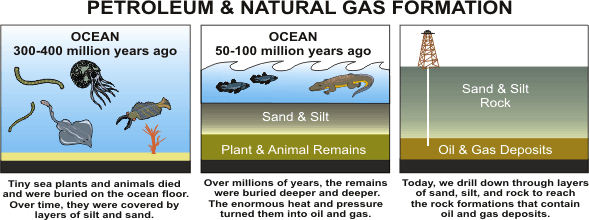Natural Gas
Like petroleum (crude oil), natural gas is made up of the remains of dead plants and animals that lived millions of years ago. Over time, petroleum undergoes further heat and high pressure deep underground. As a result, a gas (not a liquid) is formed. Natural gas is mostly methane. Methane is a compound composed of one carbon atom and four hydrogen atoms. Methane is often found at the top of reservoirs above petroleum.

Natural gas is stored in huge storage tanks or in underground gas wells. It is moved by large pipelines to get to communities and industries where it will be used.

We measure and sell natural gas in cubic feet (volume) or in British Thermal Units or BTUs (heat content). One BTU is the heat required to raise the temperature of one pound of water one degree Fahrenheit.
One cubic foot of natural gas has about 1031 BTU. A box 10 feet deep, 10 feet long, and 10 feet wide would hold one thousand cubic feet of natural gas.

